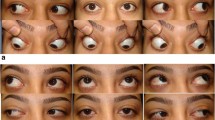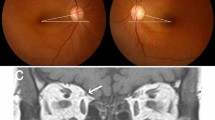Abstract
Purpose
To determine the position of rectus muscle pulleys in Japanese eyes and to evaluate the effect of oblique muscle surgery on rectus muscle pulleys.
Methods
Quasi-coronal plane MRI was used to determine area centroids of the 4 rectus muscles. The area centroids of the rectus muscles were transformed to 2-dimensional coordinates to represent pulley positions. The effects of oblique muscle surgery on the rectus muscle pulley positions in the coronal plane were evaluated in 10 subjects with cyclovertical strabismus and, as a control, pulley locations in 7 normal Japanese subjects were calculated.
Results
The mean positions of the rectus muscle pulleys in the coronal plane did not significantly differ from previous reports on normal populations, including Caucasians. There were significant positional shifts of the individual horizontal and vertical rectus muscle pulleys in 3 (100%) patients with inferior oblique advancement, but not in eyes with inferior oblique recession and superior oblique tendon advancement surgery. The surgical cyclorotatory effect was significantly correlated with the change in the angle of inclination formed by the line connecting the vertical rectus muscles (p = 0.0234), but weakly correlated with that of the horizontal rectus muscles.
Conclusions
The most important factor that affects the pulley position is the amount of ocular torsion, not the difference in surgical procedure induced by oblique muscle surgery.





Similar content being viewed by others
References
Forbes G, Gehring DG, Gorman CA, Brennan MD, Jackson IT. Volume measurements of normal orbital structures by computed tomographic analysis. Am J Neuroradiol. 1985;6:419–24.
Ozgen A, Ariyurek M. Normative measurements of orbital structure using CT. AJR. 1998;170:1093–6.
Nishida Y, Hayashi O, Nishida E, Murata T, Aoki Y, Inatomi A, et al. Volume measurement of the horizontal extraocular muscles using magnetic resonance imaging. Jpn J Ophthalmol. 1996;40:439–46.
Tian S, Nishida Y, Isberg B, Lennerstrand G. MRI measurements of normal extraocular muscles and other orbital structure. Graefe’s Arch Clin Exp Ophthalmol. 2000;238:393–404.
Ozgen A, Aydingöz U. Normative measurements of orbital structures using MRI. J Comput Assist Tomogr. 2000;24:493–6.
Iwata-Amano E, Sato M, Ukai K, Terasaki H. Magnetic resonance imaging of the extraocular muscle path before and after strabismus surgery for a large degree of cyclotorsion induced by macular translocation surgery. Jpn J Ophthalmol. 2009;53:131–7.
Miller JM. Functional anatomy of normal human rectus muscles. Vision Res. 1989;29:223–40.
Demer JL, Miller JM, Poukens V, Vinters HV, Glasgow BJ. Evidence for fibromuscular pulleys of the recti extraocular muscles. Invest Ophthalmol Vis Sci. 1995;36:1125–36.
Robinson DA. A quantitative analysis of extraocular muscle cooperation and squint. Invest Ophthalmol Vis Sci. 1975;14:801–25.
Demer JL, Oh SY, Poukens V. Evidence for active control of rectus extraocular muscle pulleys. Invest Ophthalmol Vis Sci. 2000;41:1280–90.
Demer JL. Pivotal role of orbital connective tissues in binocular alignment and strabismus. The Friedenwald lecture. Invest Ophthalmol Vis Sci. 2004;45:729–38.
Demer JL, Miller JM. Orbital imaging in strabismus surgery. In: Rosenbaum AL, Santiago AP, editors. Clinical strabismus management. Philadelphia: Sanders; 1999. p. 84–98.
Clark RA, Miller JM, Demer JL. Location and stability of rectus muscle pulleys inferred from muscle paths. Invest Ophthalmol Vis Sci. 1997;38:227–40.
Clark RA, Miller JM, Demer JL. Three-dimensional location of human rectus pulleys by path inflections in secondary gaze positions. Invest Ophthalmol Vis Sci. 2000;41:3787–97.
Kono R, Okanobu H, Ohtsuki H, Furuse T. Findings by magnetic resonance imaging of rectus muscle pulleys in normal persons. Rinsho Ganka (Jpn J Clin Ophthalmol). 2009;63:1537–41.
Kono R, Clark RA, Demer JL. Active pulleys: magnetic resonance imaging of rectus muscle path in tertiary gaze. Invest Ophthalmol Vis Sci. 2002;443:2179–88.
Velez FG, Clark RA, Demer JL. Facial asymmetry in superior muscle palsy and pulley heterotopy. J AAPOS. 2004;4:233–9.
Hisatomi C. The Eyelid. In: Manabe R, editor. New clinical Ophthalmology Shin Rinshogankazensho Geganb, Zenganbu 6A (in Japanese). Tokyo: Kanehara; 1993. p. 1–13.
Tane F. Orbital disease, Ocular misalignment. In: Manabe R, editor. New clinical Ophthalmology Shin Rinshogankazensho Geganb, Zenganbu 6A In Japanese). Tokyo: Kanehara; 1993. p. 273–85.
Clark RA, Rosenbaum AL, Demer JL. Magnetic resonance imaging after surgical transposition defines the anteroposterior location of the rectus muscle pulleys. J AAPOS. 1999;3:9–14.
Clark RA, Demer JL. Rectus extraocular muscle pulley displacement after surgical transposition and posterior fixation for treatment of paralytic strabismus. Am J Ophthalmol. 2002;133:119–28.
Demer JL, Miller JM, Poukens V. Surgical implications of the rectus extraocular muscle pulleys. J Pediatr Ophthalmol Strabismus. 1996;33:208–18.
Clark RA, Demer JL. Magnetic resonance imaging of the effect of horizontal rectus extraocular muscle surgery on pulley and globe positions and stability. Invest Ophthalmol Vis Sci. 2006;47:188–94.
Kono R, Ohtsuki H, Okanobu H, et al. Displacement of rectus muscle pulleys by torsional muscle surgery for treatment full macular translocation induced-cyclotropia. Am J Ophthalmol. 2005;140:144–6.
Wright KW. Inferior oblique muscle surgery. In: Wright KW, editor. Color atlas of ophthalmic surgery. New York: Lippincott; 1991. p. 173–99.
Eckardt C, Eckardt U, Conrad H-G. Macular translocation with and without counter-rotation of the globe in patients with age-related macular degeneration. Graefe’s Arch Clin Exp Ophthalmol. 1999;237:313–25.
Fujikado T, Shimojyo H, Hosohata J, Tsujikawa K, Fukui T, Ohji M, et al. Effect of simultaneous oblique muscle surgery in foveal translocation by 360° retinotomy. Graefe’s Arch Clin Exp Ophthalmol. 2002;240:21–30.
Del Monte MA, Wright KW. Superior oblique strengthening procedure. In: Wright KW, editor. Color atlas of ophthalmic surgery. New York: Lippincott; 1991. p. 145–71.
Russmann W, Fricke J, Neugebauer A. Untersuchung der Motorik. Messung der Fehlstellung. In: Kaufmann H, editor. Strabismus. Stuttgart: Thieme; 2004. p. 344–69.
Schworm HD, Eithoff S, Schaumberger M, Boergen KP. Investigation on subjective and objective cyclorotatory changes after inferior oblique muscle recession. Invest Ophthalmol Vis Sci. 1997;38:405–12.
Horikawa A, Hirai Y, Kono R, Hasebe S, Otsuki H. Evaluation of cyclodeviation by scanning laser ophthalmoscope- comparison of subjective and objective cyclodeviation in vertical strabismus. Rinsho Ganka. 2000;54:85–8. (in Japanese).
Bixenman WW, von Noorden GK. Apparent foveal displacement in normal subjects and incyclotropia. Ophthalmology. 1982;89:58–62.
Inatomi A. Studies of cyclodeviation. Nippon Ganka Gakkai Zasshi. 1987;91:1119–36.
Clark RA, Demer JL. Effect of aging on human rectus extraocular muscle paths demonstrated by magnetic resonance imaging. Am J Ophthalmol. 2002;134:872–8.
Krzizok TH, Kaufmann H, Traupe H. Elucidation of restrictive motility in high myopia by magnetic resonance imaging. Arch Ophthalmol. 1996;1115:1019–27.
Krzizok TH, Schroeder BU. Measurement of recti eye muscle paths by magnetic resonance imaging in highly myopic and normal subjects. Invest Ophthalmol Vis Sci. 1999;40:2554–60.
Demer JL, Oh SY, Clark RA, Poukens V. Evidence for a pulley of the inferior oblique muscle. Invest Ophthalmol Vis Sci. 2003;44:3856–65.
Kono R, Poukens V, Demer JL. Superior oblique muscle layers in monkeys and humans. Invest Ophthalmol Vis Sci. 2005;46:2790–9.
Demer JL, Clark RA. Magnetic resonance imaging of human extraocular muscle during static ocular counterrolling. J Neurophysiol. 2005;94:3292–302.
Oh SY, Poukens V, Demer JL. Quantitative analysis of extraocular muscle global and orbital layers in monkey and human. Invest Ophthalmol Vis Sci. 2001;42:10–6.
Demer JL. Current concepts of mechanical and neural factors in ocular motility. Curr Opin Neurol. 2006;19:4–14.
Acknowledgments
This study was supported in part by a Grant-in-Aid (20592044 and 22591964) from the Ministry of Education, Science, Sports, and Culture of Japan in Japan. The authors thank Kazushi Kinugasa, Director of the National Agency for Automotive Safety and Victims’ Aid, Okayama Ryogo Center, Okayama, Japan, who provided the MRI facility and equipment. We express our deep gratitude to Professor Joseph L. Demer of the Jules Stein Eye Institute, University of California, Los Angeles, USA, for valuable advice and comments on the manuscript.
Author information
Authors and Affiliations
Corresponding author
About this article
Cite this article
Okanobu, H., Kono, R. & Ohtsuki, H. Effects of oblique muscle surgery on the rectus muscle pulley. Jpn J Ophthalmol 55, 514–524 (2011). https://doi.org/10.1007/s10384-011-0051-1
Received:
Accepted:
Published:
Issue Date:
DOI: https://doi.org/10.1007/s10384-011-0051-1




